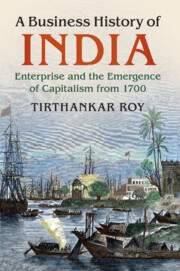Book contents
- A Business History of India
- A Business History of India
- Copyright page
- Dedication
- Contents
- Figures
- Maps
- Tables
- Boxes
- Preface
- 1 Introduction
- 2 The Baseline at 1700
- 3 The Indian Ocean Sphere: 1700–1850
- 4 Capital and Empire (1850–1930)
- 5 Capital and Empire (1850–1930)
- 6 State and Industrialisation: 1930–1950
- 7 State and Industrialisation: 1950–1980
- 8 Revival: 1980–2000
- 9 Capital and Globalisation: 2000–2015
- 10 Conclusion
- References
- Index
3 - The Indian Ocean Sphere: 1700–1850
Published online by Cambridge University Press: 20 March 2018
- A Business History of India
- A Business History of India
- Copyright page
- Dedication
- Contents
- Figures
- Maps
- Tables
- Boxes
- Preface
- 1 Introduction
- 2 The Baseline at 1700
- 3 The Indian Ocean Sphere: 1700–1850
- 4 Capital and Empire (1850–1930)
- 5 Capital and Empire (1850–1930)
- 6 State and Industrialisation: 1930–1950
- 7 State and Industrialisation: 1950–1980
- 8 Revival: 1980–2000
- 9 Capital and Globalisation: 2000–2015
- 10 Conclusion
- References
- Index
Summary
Chapter 2 described the land trade and the sea trade. This chapter will describe how their separation began to end. Early in the 1700s, the Mughal Empire disintegrated, and merchants and bankers started to leave their former settlements on overland trading routes, for the safety of the capital cities of new states like Awadh, Bengal, Hyderabad, Maratha domains in central India, and Gujarat. In the late 1700s, warfare and conflict would cause the decline of many of these states as well. The cities with a secure future at this time were Calcutta, Bombay, and Madras, three settlements under the British East India Company. Merchants and bankers now went to these cities or developed strong connections there. At the turn of the next century, these towns had transformed from the Company's garrison and fort to Indian business cities.
During the 150 years covered in this chapter, state power changed in India. In the last quarter of the eighteenth century, the Company was changing from being a business firm to a political entity. Between 1757 and 1765, the British East India Company emerged as the effective ruler of Bengal, one of the richer independent states of post-Mughal India. It was also a strong military force in Bombay and Madras. In 1813, the monopoly charter was withdrawn, and trade became formally free. The effect was dramatic as not only European private merchants, but also artisans, planters, skilled professionals, and fortunehunters, migrated from Britain to the port cities.
While trading and diaspora links between Britain and India were thus developing, the Industrial Revolution unfolded in Britain. India changed from being a textile exporter to a textile importer, and at the same time, started exporting agricultural goods, like opium, indigo, cotton, and tea to Britain and to the Company's sphere of influence in China. In the early 1800s, Indo- European firms based in Bombay, Calcutta, and Madras exported agricultural goods that came from the interior. Sea trade and land trade began to converge.
What did this twofold change mean for business firms? Migrant merchant families relied on their own traditional contacts and organisation. At the same time, in the port cities, new types of hybrid enterprises emerged.
- Type
- Chapter
- Information
- A Business History of IndiaEnterprise and the Emergence of Capitalism from 1700, pp. 40 - 68Publisher: Cambridge University PressPrint publication year: 2018



